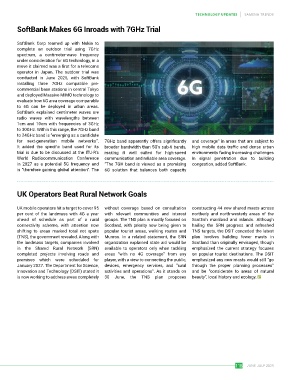Page 118 - SAMENA Trends - June-July 2025
P. 118
TECHNOLOGY UPDATES SAMENA TRENDS
SoftBank Makes 6G Inroads with 7GHz Trial
SoftBank Corp teamed up with Nokia to
complete an outdoor trial using 7GHz
spectrum, a centimeter-wave frequency
under consideration for 6G technology, in a
move it claimed was a first for a telecoms
operator in Japan. The outdoor trial was
conducted in June 2025, with SoftBank
installing three 7GHz compatible pre-
commercial base stations in central Tokyo
and deployed Massive MIMO technology to
evaluate how 6G area coverage comparable
to 5G can be deployed in urban areas.
SoftBank explained centimeter waves are
radio waves with wavelengths between
1cm and 10cm with frequencies of 3GHz
to 30GHz. Within this range, the 7GHz band
to 24GHz band is “emerging as a candidate
for next-generation mobile networks”. 7GHz band apparently offers significantly and coverage” in areas that are subject to
It added the specific band used for its broader bandwidth than 5G’s sub-6 bands, high mobile data traffic and dense urban
trial is due to be discussed at the ITU-R’s making it well suited for high-speed environments facing increasing challenges
World Radiocommunication Conference communication and reliable area coverage. in signal penetration due to building
in 2027 as a potential 5G frequency and “The 7GH band is viewed as a promising congestion, added SoftBank.
is “therefore gaining global attention”. The 6G solution that balances both capacity
UK Operators Beat Rural Network Goals
UK mobile operators hit a target to cover 95 without coverage based on consultation constructing 44 new shared masts across
per cent of the landmass with 4G a year with relevant communities and interest northerly and north-westerly areas of the
ahead of schedule as part of a rural groups. The TNS plan is mostly focused on Scottish mainland and islands. Although
connectivity scheme, with attention now Scotland, with priority now being given to hailing the SRN progress and refreshed
shifting to areas marked total not spots popular tourist areas, walking routes and TNS targets, the DSIT conceded the latest
(TNS), the government revealed. Along with Munros. In a related statement, the SRN plan involves building fewer masts in
the landmass targets, companies involved organization explained state aid would be Scotland than originally envisaged, though
in the Shared Rural Network (SRN) available to operators only when tackling emphasized the current strategy focuses
completed projects involving roads and areas “with no 4G coverage” from any on popular tourist destinations. The DSIT
premises which were scheduled for player, with a view to connecting the public, emphasized any new masts would still “go
January 2027. The Department for Science, devices, emergency services, and “rural through the proper planning processes”
Innovation and Technology (DSIT) stated it activities and operations”. As it stands on and be “considerate to areas of natural
is now working to address areas completely 30 June, the TNS plan proposes beauty”, local history and ecology.
118 JUNE-JULY 2025

